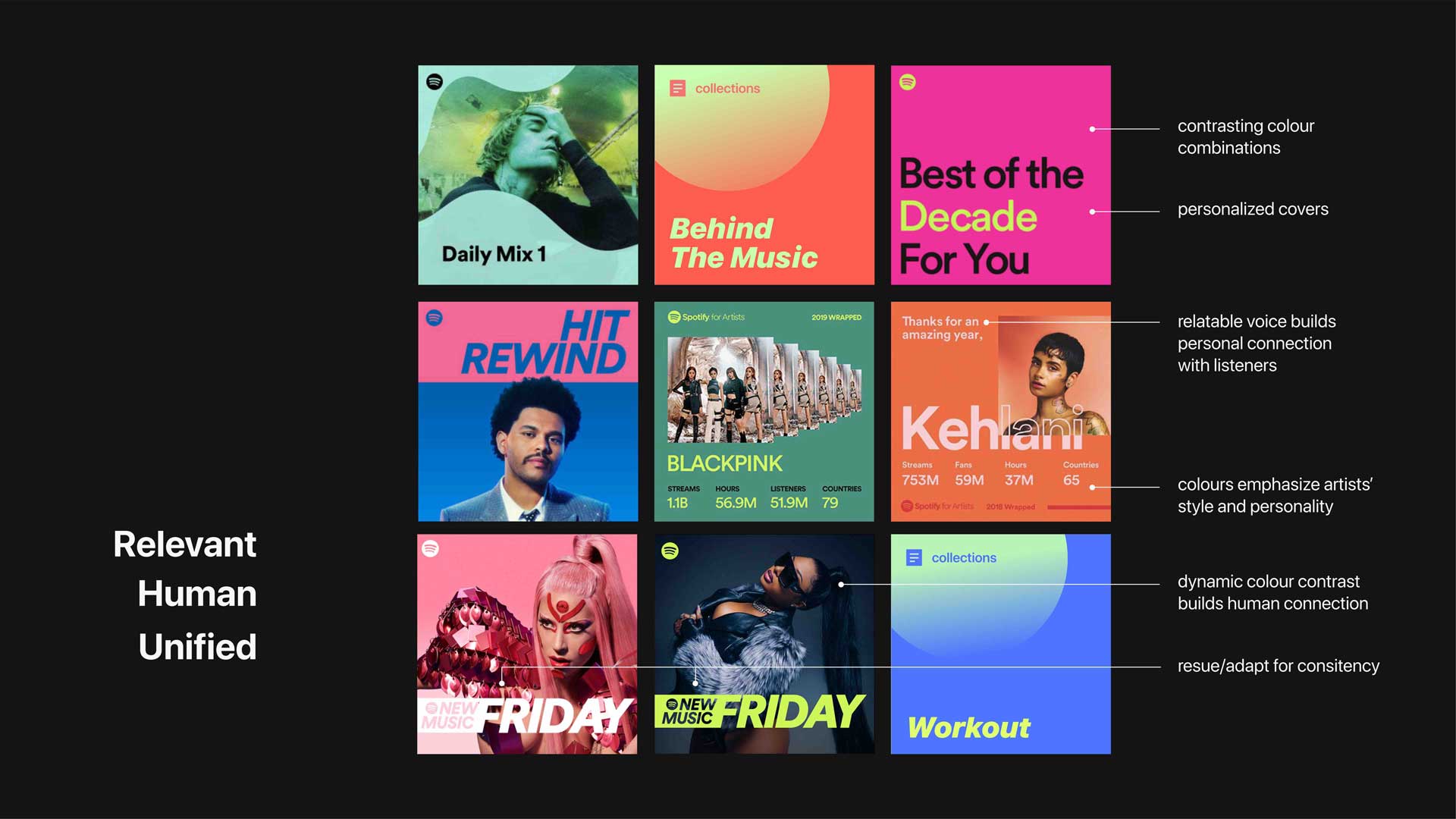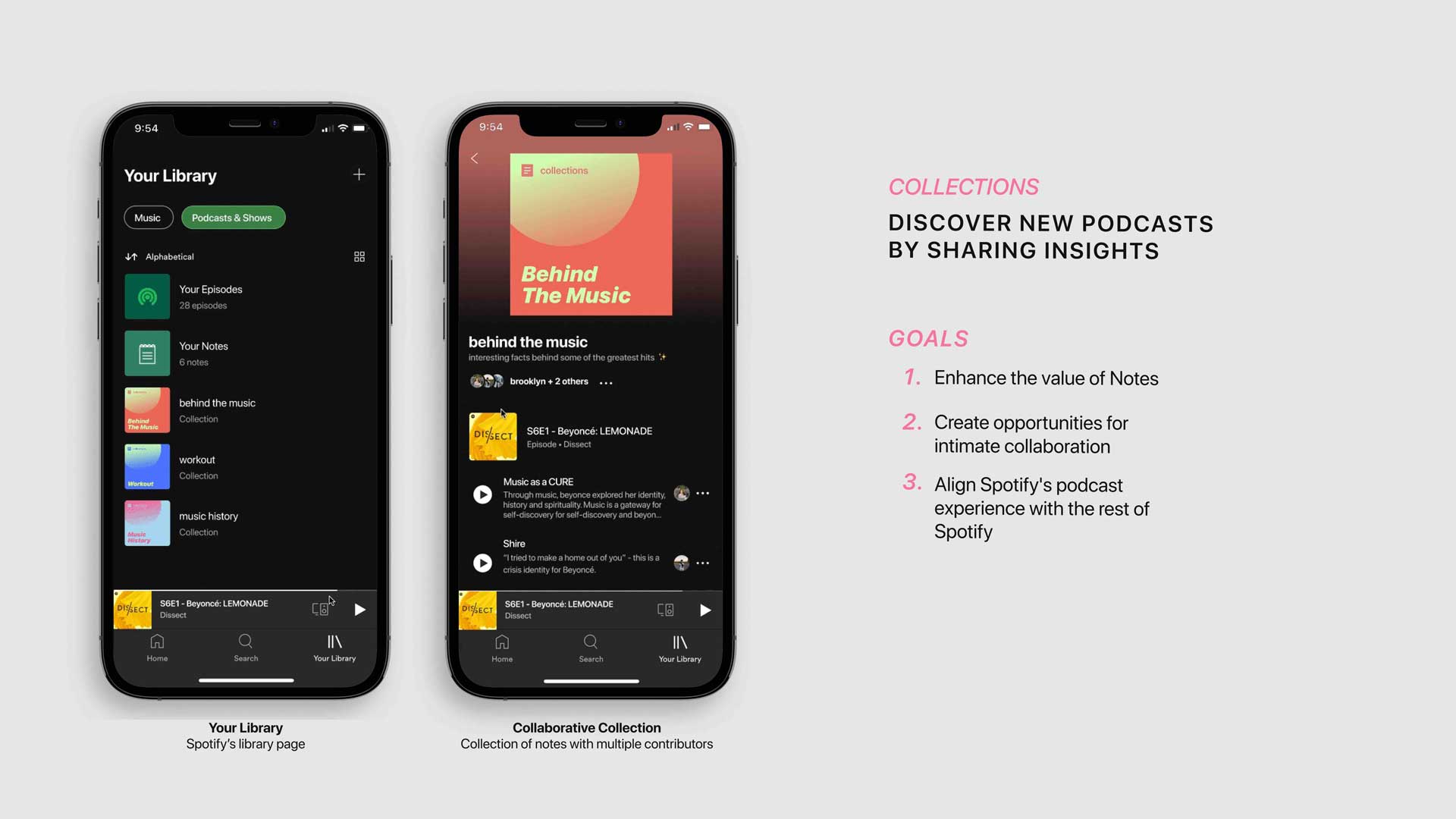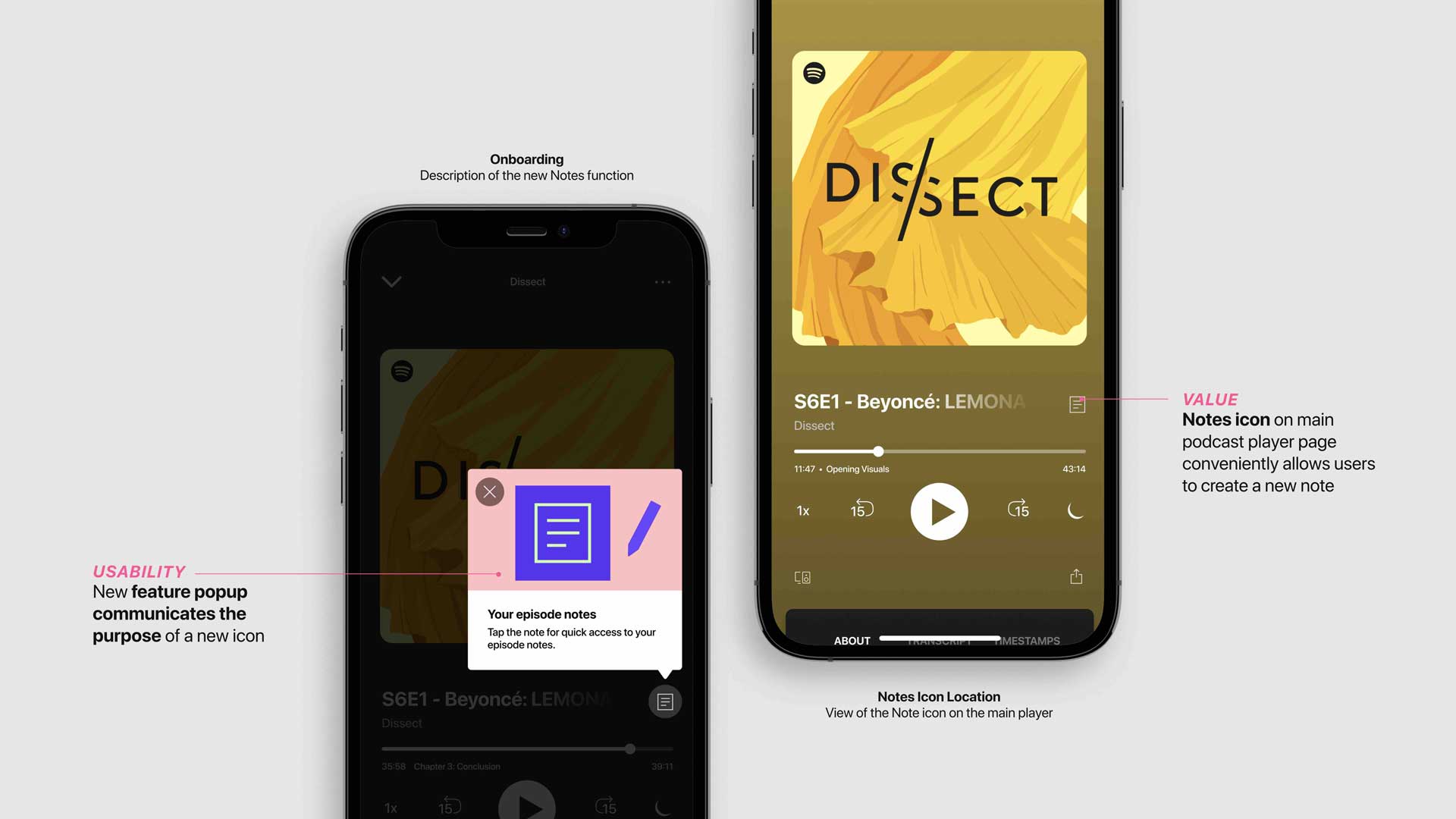Project Description
Spotify Collections is an academic case study created for a senior experience design course, IAT 438. For this project, we were tasked
to select a client with a business problem that fell within the constraints of the project. Our goal, as designers, was to develop and
propose a meaningful digital intervention that could potentially help the client
Spotify Collections
A revamp and extension of Spotify's current podcast sector. As designers, we designed a note-taking and sharing solution for engaged
podcast listeners. Spotify Collections' goal is to narrow the value gap between the music and podcast sides of Spotify. Focusing on
Spotify's audio (podcast) player and personal profile of the users, we added three main features, which includes notes, collections,
and transcript.
The Client
Spotify is known as one of the leaders in music streaming, currently they are tying to position themselves as the go-to podcast platform
to expand their presence in the audio industry.
In 2019, Spotify began by acquiring Gimlet, a narrative podcasting company, and Anchor, a podcast creator platform. In late 2020, they
signed with several of the current largest podcasters such as The Joe Rogan Experience for exclusive streaming rights.
As of Spring 2021, Spotify was the most used podcast platform. With big companies such as Amazon, Apple, and Google entering the market,
Spotify needs to maintain their position.
Spotify's Brand
How do podcasts fit with Spotify's brand? Spotify's brand tagline, Music for Everyone, is supported by their brand values of:
- Collaborative: Creators, consumers, and everyone in between
- Personal: Tailored experiences
- Innovative: Quick to adapt
Problem Area + Business Problem
Our project aims to explore Spotify's growing interest in the podcasting industry. Through our research we found that the customer segment
— the engaged listener — has refrained from moving to Spotify due to the lack of support within the podcast consumption experience.
Engaging with podcasts is greatly different than listening to music. If Spotify aims to maintain their podcast dominance, they must adapt
their player to be the best for podcasts as well as music.
User Research + Target Audience
To establish our project, we began our initial research by looking at the end-to-end journey of a podcast and how Spotify and other
stakeholders fit into that journey. We identified six stakeholders: Spotify, their direct competitors, other competitors, investors,
podcast creators, and podcast consumers. We studied how the stakeholders were all connected and impacted by each other. From these
stakeholders, we further enhanced our focus on the podcast consumer
Framing
By identifying the disconnect between Spotify's music and podcast players, we framed our experience design intervention around the
following question:
How might we enhance the experience of engaged podcast listeners through Spotify’s audio player, in order to establish Spotify
as the premiere podcast platform?
Journey Map
Using a simplified customer journey map, we outlined the two listeners groups (passive listener and engaged listener) and their
podcast experience on Spotify.
Spotify currently does not provide listeners with the opportunity to engage with the podcasts. The absence of a supported
experience is a missed opportunity for Spotify to act upon its brand values on the podcast side. Our project aims to address
this opportunity by engaging with Spotify's brand values of innovation and collaboration.
Music vs Podcast
Breaking down the features Spotify provides in supporting music and podcast listeners, we discovered significantly more
features available for music listeners such as smart playlist generation, group listening, song storylines.
In terms of the audio player, there's a clear gap for podcast specific features compared to Spotify music.
For creators, all of Spotify's tools for creating podcasts exist outside of Spotify's platform. From a social perspective,
there is an opportunity for Spotify to provide a unique opportunity for sharing podcasts.
Feature Ideation & Opportunities
We brainstormed interventions that aligned with Spotify’s brand while also creating a premium experience for
podcast listeners. We narrowed down the following ways we could tailor Spotify’s audio plater to better suit
the needs of podcast listeners in order to increase customer engagement and solidify Spotify as an audio leader.
- User Interface Revamp
- Transcripts
- Shownotes
- Previews/Clips
To further ideate our proposed solutions, we conducted a 5 days-long Design Sprint with this question in mind:
Will streamlining the podcast consumer experience into the Spotify app establish Spotify as a podcast consumption
destination for frequent podcast users?
Since our chosen area of opportunity focused heavily on the podcast player, our exploration became less about
the discovery of podcasts, and more on the process of consuming it. From our sprint, we realized that these features
had to not only affect the direct consumption experience but also include the pre and post-listening experience to
support discovery and discourse. After researching and analyzing features on other platforms, each member began
sketching possible features and interactions that could be incorporated into Spotify to enhance the direct
consumption experience.
Podcasts are a very different format than music, resulting in a different engagement experience. From our user
testing, we discovered that there was a clear divide between those who fully engaged with podcasts and those who
passively listen to podcasts while doing other activities. Engaged listeners often had alternative apps or routines
to take notes or share content, and it just “made sense” for those to be put into Spotify for a streamlined experience.
Some of them used other podcasting apps, and these features would encourage them to make the change to using Spotify.
This directly answered our sprint question and gave us the confidence to move forward with the concept.
Proposed Solution
Spotify Collections, a note taking and sharing solution for engaged podcast listeners. Focusing on Spotify's
audio (podcast) player and personal profile of the users, we added three main features, which includes notes,
collections, and transcript. This solution revamps and extends Spotify's current podcast sector while narrowing
the value gap between the music and podcast sides of Spotify.
Our proposed solutions aims to:
- Provide additional value to listeners by giving them the features they need on one platform
- Reduce cognitive overhead by streamlining the listening process through new interactions
- Reduce cognitive overhead by streamlining the listening process through new interactions
Feature Overview

overview of our proposed features
Our proposed solution, Spotify Collections, bridges the value gap between the music and podcast
sides of Spotify, by adding notes, collections, and transcript features to the Spotify podcast player.
This supports engaged listeners that derive value from interaction within the player.
Art Direction

a blend of spotify and our team's cover artworks
Our art direction strategy was mainly inspired from Spotify's existing visual identity. Their design
team operates under 3 design principles:
- Relevant: reflects both artist and listeners as individuals
- Human: communication, expression and human connection
- Unified: how Spotify establishes coherence across their features and and apps
These qualities can be seen through personalized collections covers, contrasting colour combinations,
as well as the relatable brand voice that builds a connection with listeners. When designing the
collections covers, we kept in mind similar characteristics and colour elements of Spotify’s existing
playlist covers to make sure our designs were unified.
Value Proposition
For Users
We confirmed that the value of Spotify Collections for the engaged listener through our user testing.
The users described that the tools would add value to their overall experience. Some users using other
podcast applications expressed that the features proposed could potentially cause them to switch over to
Spotify from their current applications.
For Spotify
Through Collections, Spotify’s brand perception also grows from just a music platform to a music and podcast
platform due to their ability to facilitate the podcast consumption journey beyond just listening. Engaged
Listeners also transition to Spotify due to the more holistic experience, increasing ad revenue and potentially
premium subscriptions.
FEATURE 1: NOTES

Onboarding
To ease and simplify the users familiarity with the notes icon, an onboarding popup appears when the
listener opens a podcast for the first time with the new feature
Your Notes
On this page, a group of your notes that have not been sorted into a collection will be visible. You
will find tags that can help with filtering through the content collected on this page. When selected
on a specific podcast episode, users will find the 'episode notes' page. Here, timestamps of the episode's
notes facilitate easy access to the clipped sections of the podcast.
Audio Clipping
The audio clipping tool quickly snips a section of the podcast to include into your notes. However,
listeners can also exclude creating a clip to make general notes. Users also have the option to note accompanying
thoughts. Adding a tag helps with sorting, before you save or add to a collection.
Lockscreen
When listeners find themselves consuming a podcast with their phone locked, our addition to the lock screen
mini-player allows listeners to instantly add a bookmark for later, or select 'create a note' to be directed into
the app. They can add a bookmark with their headphones by performing a short press, followed by a press and hold
until they hear a beep.
Bookmarks
Bookmarks are for those who would like to mark a section of a podcast without dedicating time to create a note.
They act as timestamps to revisit on the episode notes page. If a note is created for a bookmarked timestamp,
the bookmark will automatically be taken out of this section. Alternatively, users can manage bookmarks by long
pressing a timestamp.
FEATURE 2: COLLECTIONS

Collections, are playlists of podcast episodes and notes that can be private, collaborative,
or public. Collections uses Spotify's existing playlist feature and existing treatment of their social aspects:
intimate and collaborative. Collections aims to enhance the value of notes by creating opportunities for intimate
collaboration and aligning Spotify's podcast experience with the rest of Spotify.
The feature can be accessed from within ‘Your Library’, where your music playlists exist. The automatically
generated cover art is unified with Spotify's art direction through it’s simple bold elements and vibrant
contrasting colours.
FEATURE 3: INFORMATION CARDS

About + Timestamps
Three tabbed card on the bottom is intuitive for Spotify users and provide them with supplementary
information without having to navigate to a different page. With a quick tap, you can explore the
episode resources to connect with the podcast or check out time stamps to get an outline of the
podcast topics.
Transcript
A live transcript is also available on the cards, providing accessibility and captions for
those who need them. Expanding to the full view includes the current chapter of the podcast
and is for additional guidance. From this screen, listeners can hold down on interesting
sections to create a note if they desire.
Reflection
Throughout this 5-week long project, my team and I went through many countless iterations
and challenges. Meeting completely remote and across different time zones due to the COVID-19
pandemic was very challenging; however, it became a very valuable part of my learning process.
It allowed me to build on my collaboration and communication skills.
Although everyone on the team had a specific roles, we were able to work together to create
a design intervention that balanced all aspects of design. As one of the primary UI and
graphic designers, it was important for me to learn to adapt to the brand of our client
and be able to create something that aligned with their values.
I am proud of my team and the efforts we put into creating these features, despite them
only being prototypes. As a Spotify user myself, I enjoyed being able to intervene and
create a feature that I could potentially see built within the platform. When user testing,
a couple of users thought our feature designs have already existed on Spotify, this
established the value of our design as well as supported our initial goals for the
project. This project helped me grow as a designer, especially in the field of UX. A lot
of business and experience design went into creating this design. Being able to gain knowledge
about the client, their brand values and incorporating that into the overall experience of
the user was very valuable and formative as a growing design student.

















